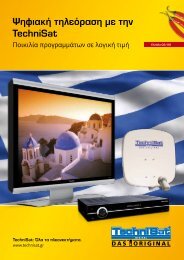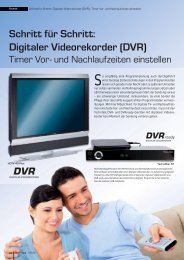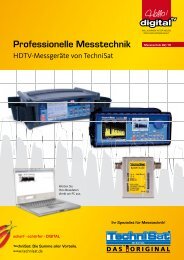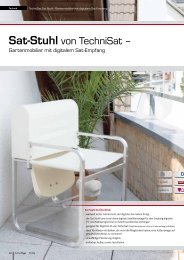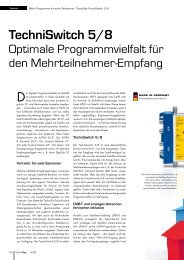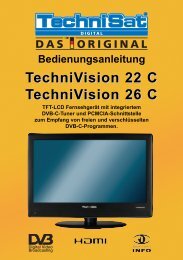Sat in the city:
Sat in the city:
Sat in the city:
You also want an ePaper? Increase the reach of your titles
YUMPU automatically turns print PDFs into web optimized ePapers that Google loves.
24<br />
Special DigitalLife<br />
INFODIGITAL December 2008<br />
A<br />
small satellite key and a suitable<br />
receiver is all you need to<br />
access hundreds of programmes<br />
<strong>in</strong> your home. The location of ASTRA<br />
19.2° East alone offers a colourful<br />
and <strong>in</strong>ternational selection of several<br />
hundred digital free-to-view satellite<br />
programmes from all over <strong>the</strong> world.<br />
Moreover, several fur<strong>the</strong>r hundred pay-<br />
<strong>Sat</strong> <strong>in</strong> <strong>the</strong> City<br />
DigiDish 33: Really large<br />
selection from small<br />
satellite antennas<br />
per-view encoded channels are also<br />
available. The parabolic antenna necessary<br />
for access<strong>in</strong>g <strong>the</strong> same is also considerably<br />
smaller than those required<br />
for analogue transmissions:<br />
This is how small <strong>the</strong> DigiDish 33 is.<br />
The digital satellites, namely <strong>in</strong> comparison<br />
to <strong>the</strong>ir analogue peers, boast a<br />
considerably higher output power.<br />
The best example of this is <strong>the</strong> Techni<strong>Sat</strong><br />
DigiDish 33. The m<strong>in</strong>i antenna,<br />
which has a diameter of barely 33 cm,<br />
appears dim<strong>in</strong>utive to <strong>the</strong> eye. However,<br />
its performance is anyth<strong>in</strong>g but.<br />
Receiv<strong>in</strong>g what previously required a<br />
parabolic antenna 65cm <strong>in</strong> diameter<br />
is no major problem for <strong>the</strong> newer<br />
and smaller version.<br />
Pr<strong>in</strong>ciple beh<strong>in</strong>d receiv<strong>in</strong>g<br />
satellite signals<br />
To receive <strong>in</strong>cidental television signals,<br />
which are transmitted via satellite, on<br />
<strong>the</strong> one hand we have <strong>the</strong> concave<br />
antenna and on <strong>the</strong> o<strong>the</strong>r, <strong>the</strong> aforementioned<br />
(round) LNB, <strong>in</strong> which frequencies,<br />
thanks to <strong>the</strong> way <strong>the</strong> curve<br />
is constructed almost as <strong>in</strong> a burn<strong>in</strong>g<br />
glass. When learn<strong>in</strong>g physics (optics)<br />
<strong>in</strong> school, we all doubtless vaguely remember,<br />
that <strong>the</strong> angle of <strong>in</strong>cidence is<br />
also <strong>the</strong> angle of reflection. The same<br />
ratio applies to <strong>the</strong> <strong>in</strong>cident signals:<br />
each satellite has a specific position<br />
<strong>in</strong> <strong>the</strong> orbit and thus transmits its relevant<br />
“Footpr<strong>in</strong>t” onto <strong>the</strong> correspond<strong>in</strong>gly<br />
positioned antenna. S<strong>in</strong>ce <strong>the</strong><br />
myriad range of satellites around <strong>the</strong><br />
world each have different orbit positions,<br />
<strong>the</strong>ir signal angles also vary and<br />
can consequently not all be picked up


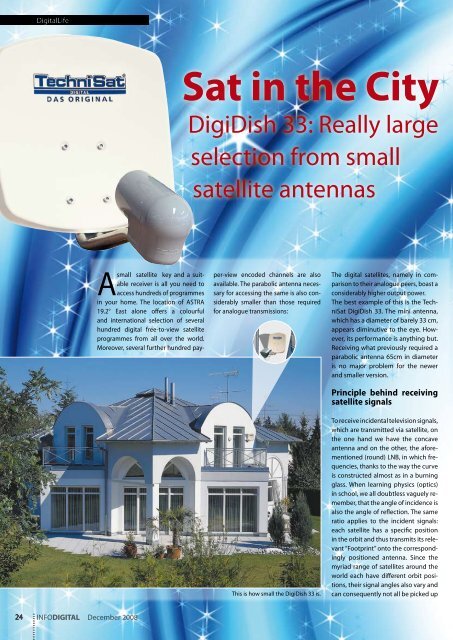
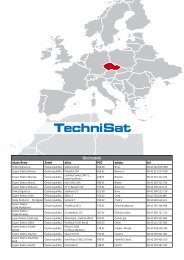

![[PDF] TV numérique avec TechniSat](https://img.yumpu.com/7390326/1/184x260/pdf-tv-numerique-avec-technisat.jpg?quality=85)
